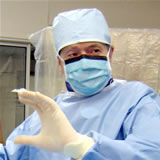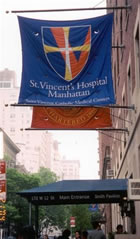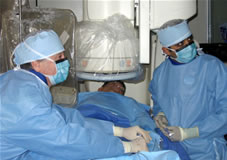
As part of
its ongoing series of interviews with physicians who practice
the transradial approach for angiography and angioplasty,
Angioplasty.Org talks with John T. Coppola, M.D. (Editor's
note: Dr. Coppola was Chief of Cardiology at St. Vincent's
Hospital in New
York
City at the time of this interview. Dr. Coppola is now at
NYU Langone Medical Center in New York.)
Dr. Coppola is internationally
recognized as an expert in performing transradial catheterization.
He has been invited to present this procedure to interventional
cardiologists in Japan, China and India. For many years,
Dr. Coppola has brought international experts in
the
transradial
technique to Manhattan for a special
radial course, where many radial practitioners in the
U.S. first were exposed to the technique.
For more about
the transradial approach, visit our Radial
Access Center. |
|

Dr. John
T. Coppola of
NYU Langone Medical
Center in NY |
Q: When did you start doing radial access, and why?
Dr. Coppola: I started doing radial access during the end of 2003.
As director of the cath lab at St. Vincent's Hospital, I had to
review all of the complications, and through my 13 years doing
this, I realized there were patients who were dying from complications
from the femoral approach. They would have bleeding complications
that would lead to renal failure, sepsis, and those things would
snowball. And after having a successful angioplasty, these patients
would die of a complication directly attributable to bleeding from
the femoral site.

St. Vincent's
Hospital |
|
I had a colleague at that
time who had a friend in India who was an Indian cardiologist
and
an expert at doing radial
angiography
and angioplasty. His friend, Dr. Tejus Patel, had at that time
probably done about 18,000 radial procedures. So, I had the
opportunity to
go to India for a week with Dr. Tak Kwan, one of my colleagues
here at St. Vincent's, and together we scrubbed with Dr. Patel
and his
staff and had hands-on experience with over 100 cases.
When we
came back in November of 2003, both Dr. Kwan and I were committed
to this
procedure, so then we worked together probably for our next 100
cases, so we both got experience together, and we both encouraged
each other
to continue our climb up the learning curve.
As we became more
comfortable with the procedure, we began to teach our interventional
fellows
the procedure, and we began to teach other attendings this
procedure, so now, as of last quarter 2007, we've done 50%
of our cases
transradially in the hospital. Personally, I've gone from
a 0% to an almost 70%
transradial approach. So, the trip to India was really the
turning point. |
Q: In terms of training, you conduct
a course at St. Vincent’s?
Dr. Coppola: Yes. I've been fortunate enough that every springtime
I've been able to attract Dr. Patel from India, who really is one
of the world's experts on transradial procedures, and Dr. Saito
from Japan, an expert at radial procedures and also chronic total
obstructions, and we've given a one-day workshop on the transradial
approach. We usually have Dr. Patel give a couple of lectures:
an anatomy lecture and one called “Tips and Tricks” --
in other words, what you can do if you run into this or that particular
situation. This course is something that we give for free -- it's
sponsored by Terumo and Boston Scientific, and they help defray
some of the cost of having the faculty and doing the course. And
it's been quite successful; we've done it for four years running
now.
Q: At the major interventional cardiology live demonstration courses
these days, the beginning of the procedure, the part where the artery
is accessed, is usually not shown.
Dr. Coppola: It's kind of interesting. One of the things that we
do here routinely is to show the arterial stick. We show how people
do it. I think that a lot of people are embarrassed. You know, when
you go to a big conference and you're surrounded by all these cardiologists,
you say, “Gee, I don't want to raise my hand and say, ‘Can
you show me how to stick the artery?’, because everyone's going
to laugh and say ‘Look at this idiot! He doesn't even know
how to stick an artery!’”
I think that when you do a course, particularly
if you're doing a basic introduction course, you really want to
say to yourself, “Hey,
there's a guy sitting out in the audience. He’s not going to
ask me the basic stuff because he doesn’t want to be embarrassed,
but I bet he'd like to know the following. . .”. So you make
sure you show the stick.
Or, if you're having a hard time getting
down the subclavian, you say, “You know, this happens very often because of the tortuosity
of the subclavian, so the best thing to do here is just say, ‘Please
take a deep breath in…’.” That'll help the catheter
go down the subclavian. That's a good little trick that people are
not going to ask, because they're embarrassed to ask how you get
the catheter into the aorta.
I think that when you're first learning the procedure, you're in
a room and you have a mentor, and he understands that you've never
done this procedure and you really don't know what's going on, so
he tells you what he's doing. But when you're in a large audience,
you're not going to ask those questions. So that's one of the problems
with some of the demonstration courses, that if the people doing
it aren't attuned to the fact that the audience member are not all
experts, you might not learn as much as you can.
Q: From your experience, what are the major benefits for patients
with the radial approach?
Dr. Coppola: For the patients, the benefit is that it's a safer procedure.
There's a lack of bleeding. And everything that's coming out now
in the literature suggests that if you have bleeding complications,
it impacts not only on your short-term, but your long-term survival.
So if a procedure has less of a risk of bleeding, it should also
theoretically translate into better survival. Having that benefit
in terms of less bleeding makes it safer, makes you feel more willing
to use potent antiplatelet agents, like IIb/IIIa inhibitors, with
some degree of impunity because you're not worrying about retroperitoneal
bleeds or groin hematomas.
I think as far as the patient is concerned,
if you're a man and you have some benign prosthetic hypertrophy,
and you have to lie
flat down in bed for six hours, it becomes very difficult to urinate.
If you have the procedure done transradially, as soon as it’s
over, you're basically sitting up, dangling your legs, or you're
actually standing up. If you have back problems, you can twist from
side to side. If you have chronic obstructive lung disease, you don't
have to lie flat down in bed. For patients who are morbidly obese,
it sometimes becomes very difficult for them to be in bed. It's also
difficult for arterial access; it's difficult to achieve hemostasis
in the morbidly obese patients, so I think radial’s the preferred
way to go. I think that just the ability to get up after a procedure
and walk to the bathroom, or even walk around your room, as opposed
to being tied down in bed, makes a big difference.
Q: In your personal experience, what is the complication rate with
femoral access -- both site complications, and sometimes complications
with vascular closure devices? There've been a lot of figures thrown
around.
Dr. Coppola: I think that certainly you can see anything in the literature
from 2% to 8%. I think that probably a 2% femoral complication rate
for patients with interventions is reasonable. I think that that
is taking into account large size hematomas, and some significant
bleeding, I think that probably most of that is really a function
of the fact that we have these patients on aspirin, Plavix, heparin,
all of those things are going to impact upon your risk of bleeding.
Q: What about nerve trauma or damage with the femoral approach?
Dr. Coppola: That's the beauty of the radial artery. There really
isn't much in the way of nerve or vein structure by the radial
artery. There's the superficial branch of the radial nerve that
supplies the outer aspect of the thumb. But you're not going to
end up with hand problems, muscle problems, foot drop, or anything
else that you can from a femoral nerve injury.
Q: We’ve
talked about the advantages for the patient. But what about the
advantages of the transradial approach for the physician, nursing
staff and hospital?
| Dr. Coppola: I think for the physician it's a little bit harder to learn, but
the advantage is that you have the safety of your patient -- it's going to make
it a little bit safer for the patient. For the hospital, the advantage is that
it's so much easier for the nursing staff to care for the patient. You have a
patient who comes up to the holding area of the cath lab after their procedure,
and you're not monitoring their ACT (Activated Clotting Time), you're not pulling
sheaths, you're not looking at the groin site to make sure there's no hematoma.
You basically have a patient who leaves the table with the wrist bandaged, and
the introducer sheath out. When the patient is ready to go up to the floor, the
nurses on that floor have a much easier time taking care of the patient. They're
not looking at the groin, they're not bringing bedpans, they're not emptying
bedpans, they're not bringing the patient water to drink -- so that makes it
much easier for the post-procedure care. |
|

Dr. Coppola
in catheterization laboratory
at St. Vincent's Hospital |
So, in theory, if you had someone tied down in bed with an introducer,
with the nurses going in every fifteen minutes to do vital signs,
check the groin for bleeding, check the ACT, you have more nursing
intensity -- so it's going to cost the hospital more money to take
care of those patients than if you had a situation where the patient
is totally ambulatory.
I think that from the nurses' point of view, the care of the patient,
the post-care, is much easier. From the hospital point of view, since
the post-care is easier, that means that it's going to be cheaper.
So all of those things are just big plusses. For the physician, the
thing that you win with is that your patients are happier, that they're
safer. So that's all good stuff. The downside is that you really
have to want to do this, you really have to want to learn how to
do this.
Q: This procedure would make it possible to actually perform outpatient
diagnostic, but also outpatient angioplasties as well?
Dr. Coppola: Absolutely. In Europe, it's not uncommon for patients
to have outpatient interventional procedures performed. In the U.S.,
the problem you run into is that the insurance companies penalize
hospitals for doing this on an outpatient basis. For most procedures,
if you do it as an outpatient, the hospital gets paid as a line-item
charge and it's much less reimbursement than they would get if they
did this as an inpatient procedure. For example, if we do a procedure,
an atherectomy, on the superficial femoral artery as an inpatient,
the DRG reimbursement is about $18,000. If you did the same patient
at 7:00am and sent them home that day, your reimbursement drops down
to about $7,000. So the hospital loses about $11,000.
Q: The hospital loses money by doing something more efficiently?
Dr. Coppola: Yeah. The physician reimbursement is no different, but
the hospital is the one that's losing. And the hospital comes back
to you and says “Listen, you're driving us broke by doing
these procedures”. So, really to get the financial benefit
of it, somewhere along the line they're going have to strike up
a bargain and say “Hey, we're not going to give you $18,000
because the patient's not staying overnight, but we're not going
give you only $8,000 -- we're going to come somewhere in between.”
Q: You’ve said that the transradial
approach is also more helpful for some peripheral interventions?
Coppola: Yes, particularly for renal interventions. The take-off
of the renal arteries is usually upward. So, coming from the radial
artery, your catheters actually drop right into the renal artery
-- you have a lot of support and very easy cannulation. I've found
that very often in older patients, particularly with hypertension,
the abdominal aorta is very torturous, and it becomes very difficult
sometimes to get good coaxial engagement of those renal arteries
coming from the groin -- yet, coming from above makes it much, much
easier. So, I've taken to doing most of my renal work from the radial
artery.
Q: Is there special equipment of any sort that's needed for doing
radial, and does the lab have to be set up differently?
Coppola: I think that we tend to use standard Judkins catheters for
our radial catheterization, I happen to particularly like the Terumo
radial introducer sheaths, I think they're nicely tapered and they
slide in nicely, so I tend to use those for my cases. There is a
slight difference in the configuration of the way that you set up
your table with the arm board and how you drape and prep things,
and that's something that every lab has a little bit of a different
nuance in doing. I copied what I saw in India, brought it back to
the States, and over the last couple of years we've sort of changed
around some of that to suit our set-up more than the set-up in India.
Q: There was some concern initially about radiation exposure for
the operators?
Coppola: Well, there have been some papers saying that the radiation
exposure [for the cardiologist] is a little bit higher – but
part of it would be where you place the arm. What we've taken to
doing, is we sort of pull the arm in to the side, so when we're operating
we're actually doing the procedure from the same location that we
would from the femoral approach.
Q: To recap for our professional audience -- what would you recommend
to a practicing cardiologist as the best step to learn the radial
approach?
Coppola: I think you need to find someone who is doing radial procedures,
and say to him, “Listen, can I come to your lab for a day and
watch you do the stick, and work with you?” I think that most
cardiologists are usually willing to teach this, and I think that
most people, for the radial approach, have become almost “apostles” of
the procedure. You're usually excited when someone shows an interest.
So I think it helps to have someone mentor you for the first ten
or so.
I also think it helps if you have a partner. If we're working together,
there's more of a tendency to stay with what you're doing. I think
that having a partner when I went to India, and coming back to St.
Vincent's together, made it easier for both of us, because both of
us were interested in doing this, and we both would encourage each
other. So, I think the two things are, I would try to get myself
a mentor to show you the first ten or so procedures, and I would
try to get another colleague interested in doing this so together
you can work together, and also, by both of you scrubbing together
on the cases, you sort of double your experience.
This interview was conducted
in November 2007 by Burt Cohen of Angioplasty.Org -- revised February
2011
|




